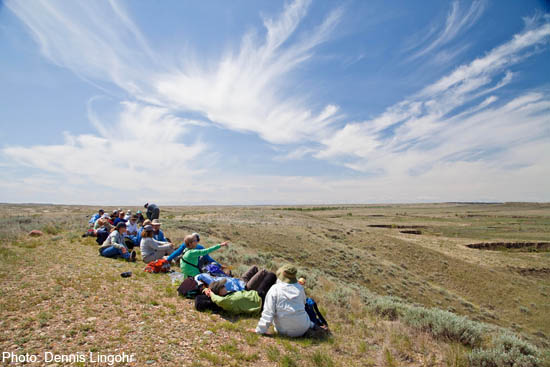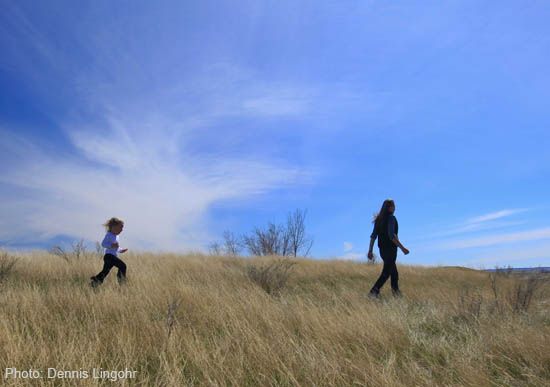Connecting With Nature Requires Public Access to the Natural WorldJuly 2012 - Originally Posted HERE.
People in the United States have a slowly eroding relationship with nature, but we could help reverse this trend with a combination of small, easy -- and some perhaps not so easy -- changes. Richard Louv's bookLast Child in the Woods suggests that Americans, particularly our children, are increasingly afflicted with what he calls "nature deficit disorder." He recommends we should, from time to time, commit to walking away from our work and electronic devises and spend more time in the outdoors experiencing pure nature. Renowned landscape painter Clyde Aspevig agrees and suggests we spend much more "aimless" time in nature engaged in what he calls land snorkeling. To land snorkel is to wander in nature with an attitude of wonder and curiosity. All good advice, but a prerequisite is easy and abundant access to nature and that opportunity, as a whole, is slipping away in many parts of this country.

Reasons contributing to this trend abound. At the macro level, the
increasing U.S population means more people requiring more land on which to live. Parking lots, buildings and roads steadily supplant remaining natural habitat. Additionally, some industries, such as logging and livestock ranching, while leasing roughly 300 millions acres of public lands, often make it challenging for private citizens to access those lands.A subtler culprit is our long-held American values regarding private property rights. As individuals, when we buy a piece of property we understandably rejoice in it finally being "ours," meaning we can do with it what want and we have no obligation to share its amenities with others. In my own state of Montana, the growing proliferation of "Keep Out" signs in the mountains and along miles of pristine
trout streams over the past fifty years is clear evidence of this trend.Here are a few suggestions that might help us move toward increased public access and increased time spent in nature.State and local governments could take a lesson from Finland, Norway, Sweden and many other countries committed to what Sweden calls
allemansrätten, or a
Freedom to Roam philosophy. Roughly translated to "every man's right," it is the idea that everyone has a right to access nature, even, within reason, on other people's private lands. These policies, in place for more than a hundred years, are cherished by these societies. The concept is bound to be condemned as "socialist" by many Americans. But local governments could enact laws that include incentives for private landowners -- such as property tax breaks -- that would compensate them for granting the public access for hiking, camping, bird watching, land snorkeling etc. on portions of their private lands. The options to dissolve this arrangement at any time and forfeit the tax break going forward might convince skeptical landowners to try such an arrangement because it provides an exit option if things don't work out.

Similarly, land trusts should more aggressively advocate for a public access component when putting lands under new conservation easements. Throughout the U.S. many land trusts grant conservation easements to private property owners who give up a variety of rights related to their property in exchange for lucrative, multi-year state and federal tax breaks. Rights relinquished might include the ability to add more buildings, roads or perhaps to till the soil. But citizens at times cry foul at this arrangement. The landowner's tax break means the revenue loss must be made up by the rest of us, but the land that was "saved" is often still surrounded by a barbed wire fence hung with "Keep Out" signs. The viewshed or wildlife corridors might have been saved, but the public's access to nature was not.Land trusts could make reasonable and prudent public access to conserved private lands (with exception to highly sensitive areas) as a part of their negotiations with the landowner and a part of their success criteria for an easement deal. The landowner could possibility get an even better tax break for selecting this item from the menu of easement rights options, and nature seekers would applaud the final outcome.

President Obama has championed a terrific new initiative called
America's Great Outdoors that seeks to conserve outdoor spaces that help the economy, shape our culture and build our outdoor traditions. Securing permanent public access should be a key aspect of this effort. We should all be looking for existing and new ideas to help to save it, and keep it open, before it is too late.At the broadest level, states should secure and protect as much land as possible --now, before it is too late -- that could permanently provide public access to important open spaces and opportunities for nature experiences. California's saving of essentially its entire 840-mile long coastline to be enjoyed by everyone, forever, is an
extraordinary example of this. Imagine the potential billions of dollars in state revenue that could be created in the short-term if California decided to sell its beautiful beaches to private owners. Instead this world-class coastline remains accessible to people of all economic classes, enabling everyone to feel very rich indeed as they stand with their feet in the waves or stroll a deserted stretch of sand. Other states currently allowing the permanent slipping away of easy access to the shorelines of beautiful lakes, rivers and streams could take a lesson from the California example.
Sean Gerrity directs the American Prairie Reserve project, the goal of which is to assemble a three and half million-acre wildlife reserve that will always be open for the public's enjoyment.


 President Obama has championed a terrific new initiative called America's Great Outdoors that seeks to conserve outdoor spaces that help the economy, shape our culture and build our outdoor traditions. Securing permanent public access should be a key aspect of this effort. We should all be looking for existing and new ideas to help to save it, and keep it open, before it is too late.At the broadest level, states should secure and protect as much land as possible --now, before it is too late -- that could permanently provide public access to important open spaces and opportunities for nature experiences. California's saving of essentially its entire 840-mile long coastline to be enjoyed by everyone, forever, is an extraordinary example of this. Imagine the potential billions of dollars in state revenue that could be created in the short-term if California decided to sell its beautiful beaches to private owners. Instead this world-class coastline remains accessible to people of all economic classes, enabling everyone to feel very rich indeed as they stand with their feet in the waves or stroll a deserted stretch of sand. Other states currently allowing the permanent slipping away of easy access to the shorelines of beautiful lakes, rivers and streams could take a lesson from the California example.Sean Gerrity directs the American Prairie Reserve project, the goal of which is to assemble a three and half million-acre wildlife reserve that will always be open for the public's enjoyment.
President Obama has championed a terrific new initiative called America's Great Outdoors that seeks to conserve outdoor spaces that help the economy, shape our culture and build our outdoor traditions. Securing permanent public access should be a key aspect of this effort. We should all be looking for existing and new ideas to help to save it, and keep it open, before it is too late.At the broadest level, states should secure and protect as much land as possible --now, before it is too late -- that could permanently provide public access to important open spaces and opportunities for nature experiences. California's saving of essentially its entire 840-mile long coastline to be enjoyed by everyone, forever, is an extraordinary example of this. Imagine the potential billions of dollars in state revenue that could be created in the short-term if California decided to sell its beautiful beaches to private owners. Instead this world-class coastline remains accessible to people of all economic classes, enabling everyone to feel very rich indeed as they stand with their feet in the waves or stroll a deserted stretch of sand. Other states currently allowing the permanent slipping away of easy access to the shorelines of beautiful lakes, rivers and streams could take a lesson from the California example.Sean Gerrity directs the American Prairie Reserve project, the goal of which is to assemble a three and half million-acre wildlife reserve that will always be open for the public's enjoyment.

